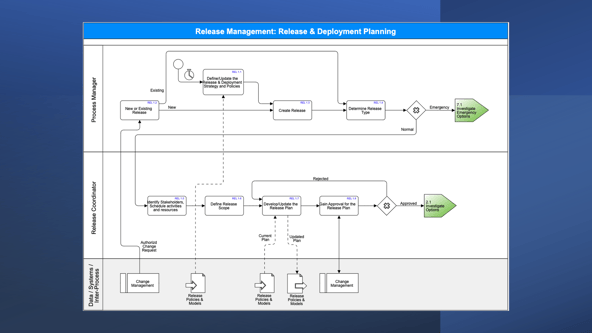Release Management Best Practices
We're pleased to provide this comprehensive guide to Release Management Process best practices. It's the perfect resource to help you define a new process or update an existing one!
Navvia is excited to provide the fifth and final best practice guide in our series of the five foundational ITSM processes every organization needs to have in place.
For each process, we provide a process description, key benefits, roles, responsibilities, a description of the significant activities, tips on process governance, and some design and implementation guidance.
Release Management Description
Effective management of software and infrastructure releases is a crucial element of IT service management. The Release Management process ensures releases are implemented efficiently and smoothly, while minimizing any risks and disruptions to the business. The process involves planning, coordinating, and controlling the release of software and infrastructure from development through testing and deployment to production.
Effective communication, collaboration, and coordination among stakeholders, including developers, testers, project managers, and business users, are essential during the release management process. Additionally, automation tools, version control systems, and change management practices can help to streamline the process and improve efficiency.
Following a well-defined release management process can help organizations reduce the risks associated with changes, maintain stability in the IT environment, and deliver new features and improvements to end-users in a controlled and efficient way.
Release Management Benefits
Release management provides organizations with the following benefits:
- Risk Mitigation: Organizations can identify and mitigate potential risks associated with deploying new releases by following a well-defined release management process, including assessing the impact on existing systems, conducting thorough testing, and planning for contingencies.
- Improved Collaboration: Release management involves collaboration between various teams, including development, operations, and quality assurance. This collaboration fosters better communication, coordination, and alignment of efforts, improving teamwork and efficiency.
- Faster Time-to-Market: With effective release management, organizations can streamline their software release cycles, reducing the time it takes to deliver new features, updates, or fixes to customers. Release Management enables faster innovation and keeps businesses competitive in rapidly evolving markets.
- Enhanced Stability and Reliability: By implementing standardized processes and rigorous testing, release management helps ensure the stability and reliability of IT systems. Release Management minimizes the chances of service disruptions, outages, or performance issues that could negatively impact business operations.
- Customer Satisfaction: By delivering high-quality releases with minimal downtime or bugs, release management contributes to improved customer satisfaction. Users can benefit from enhanced system performance, bug fixes, and new features that address their needs and expectations.
Release Management and Cyber Security
Release Management is an essential aspect of cybersecurity that entails the planning, scheduling, and controlling software releases and updates within an organization's IT environment.
Organizations can ensure that all software changes are thoroughly tested for security vulnerabilities before deployment by implementing a structured Release Management process.
This proactive approach significantly reduces the risk of introducing malware or weaknesses into the system, safeguarding sensitive data and critical assets.
Effective Release Management also enhances compliance with industry regulations by maintaining a clear audit trail of all software changes.
Prioritizing Release Management as part of a comprehensive cybersecurity strategy is vital for mitigating risks associated with software deployment and maintaining a resilient IT infrastructure.
Read our post on Boosting Cyber Resilience with IT Security Assessments and ITSM Processes for more information on improving your cyber security posture.
Release Management Roles and Responsibilities
Having clearly defined roles and responsibilities is crucial for the efficient execution of any process. This clarity helps ensure everyone is on the same page and clearly understands their place in the process.
Process roles are not to be confused with any hierarchical status within the organization, and their responsibilities are limited to that particular process.
Here are some typical Release Management roles:
Release Management Process Owner
A Senior Manager who is responsible for ensuring that all departments within the IT organization implement and use the process effectively.
Their specific tasks include:
- Defining the process's mission.
- Communicating process goals and objectives to all stakeholders.
- Resolving any cross-functional issues.
- Ensuring consistent execution across departments.
- Reporting on process effectiveness to senior management.
- Initiating process improvements as necessary.
Process Manager
In charge of overseeing the daily operations of the process, Process Managers play a vital role in ensuring the consistent and efficient execution of the process throughout the entire organization. They work closely with the Process Owner to ensure all activities are carried out according to the established guidelines. Their responsibilities include:
- Managing the day-to-day tasks of the process
- Collecting and analyzing process metrics
- Monitoring compliance
- Addressing any issues that may arise
- Leading process meetings
Release Coordinator
The Release Coordinator oversees the process for a particular release, ensuring that it adheres to the established guidelines. Their role involves guaranteeing compliance with the process and being accountable for various tasks related to managing a specific release. Responsibilities include
- Create a comprehensive release plan that includes validating the back-out plan, staging pilot tests, and executing the full deployment of the release.
- Serves as a bridge between management and the relevant stakeholders
- Engages the necessary resources to ensure the completion of specific release activities
- Promotes effective team collaboration to ensure timely implementation of releases
- Produces and maintains appropriate training and communications
- Evaluate and update the communications plan to maintain its effectiveness throughout the release process
- Communicates release goals and scope to users
- Communicates release status, progress, and issues to appropriate groups
- Validates that production versions of software and software licenses will be stored and made available.
Application Coordinator
The Application Coordinator plays a crucial role in exploring various design options, such as in-house coding or purchasing, and ensuring that software code's design, coding, and unit testing within an application area adhere to corporate standards. This role may involve assigning multiple individuals for a single release to ensure the application's success.
Testing Coordinator
The Testing Coordinator is crucial in overseeing the release's functional, regression, operational, and user acceptance testing. They are responsible for defining the necessary environmental requirements for testing and ensuring their verification. Additionally, the Testing Coordinator ensures the development or selection of appropriate test scripts/cases for thorough testing and provides necessary QA signoff for Releases.
Change Manager / CAB
The Change Manager is a valuable resource for clarifications and additional insights on the RFCs submitted for the release. It is essential to keep the CAB updated on the progress of a release and any modifications made to its contents or the release and deployment plan.
Release Management Activities

Here at Navvia, we strongly believe in simplifying complex processes by breaking them into high-level activities.
These activities serve as a guide, outlining the crucial steps in the process and the connections between them. We then map out the detailed tasks required to complete each activity. Organizing processes in this way makes understanding and communicating the process easier.
The following are the critical activities of the Release Management Process.
Release & Deployment Planning
If you are planning to release and deploy a new service, it is vital to have a comprehensive Service Transition Plan. This plan outlines the guidelines for moving the service from development to production.
The plan includes handling approved change requests and planning tasks such as defining the strategy, creating a release record, identifying stakeholders, and developing the Release and Deployment Plan. The plan should cover all aspects of testing, packaging, building, deployment, distribution, and budgeting.
Working with Change Management to define and agree upon the Release and Deployment Plan is crucial.
Prepare for Build, Test and Deployment
The Service Design and Release Design undergo validation to ensure that all requirements are met. This activity helps to identify and measure any risks or issues with the services and CIs. Once identified, the issues are prioritized, and necessary actions are taken to resolve them.
Build & Test
This activity covers the items required to prepare and unit test the release package. It includes investigating options, creating the design specifications, procuring or building the solution, setting up the environment and test cases, identifying the support procedures, assembling the completed release package, and testing the release package.
Deployment (Rollout) Planning
This activity involves identifying the customer impact and resource requirements, creating the implementation steps and procedures, developing the Deployment Plan, and submitting the plan to Change Management for approval.
Communication, Preparation & Training
This activity alerts IT and the business that the release is about to be implemented. It encompasses communicating the action requirements to all stakeholders, notifying other interested parties, and conducting the training.
Deployment (Distribution & Installation)
This activity encompasses the steps necessary to physically introduce the release into the live environment. It includes executing the implementation procedures, validating the results, recording known errors introduced into the environment, and updating the service configuration information.
Emergency Release
This activity expedites the Release Deployment Management process to address emergencies. The goal is to implement a release in the shortest possible timeframe while maintaining an acceptable, albeit increased, level of risk.
Release Management Process Governance
Process governance is an essential aspect of the Release Management process. It involves establishing a framework to ensure an organization effectively manages and executes the process.
The Release Management process owner plays a critical role in process governance, defining the process's mission and communicating its goals and objectives to all stakeholders. They also resolve cross-functional issues and initiate improvements to enhance the process's effectiveness.
The Release Manager oversees the daily implementation of the process, ensuring uniform execution throughout the organization. They collect and present process metrics, monitor compliance and report process-related issues.
Working as a team, the process owner, process manager, and other stakeholders should periodically assess the process, looking for gaps and potential areas of improvement. One way to do this is through a formal process assessment. Learn more about assessments by reading The Importance of a Process Maturity Assessment.
Through process governance, organizations can maintain consistency, efficiency, and continuous improvement in their Release Management practices.
Release Management Process Design and Implementation
Believe it or not, implementing an ITSM process is more complex than just installing an ITSM tool. It requires a well-defined process to ensure a successful implementation. To help organizations navigate this process, we recommend following these five steps:
- Identify gaps in your current process and supporting tools: Before implementing a new process, it's important to assess your existing process and tools to identify any areas that may need improvement. This review should include outdated documentation, gaps in ITSM tool functionality, or lack of integration between different systems.
- Collaborate with stakeholders to understand their process requirements: Involving all relevant stakeholders in the implementation process is crucial. These stakeholders include not only the information technology team but also all business stakeholders. By engaging with stakeholders early on, you can gather their input and ensure that their requirements are included in the design and implementation of the Release Management process.
- Define and document your Releasse Management process: Once you have identified the gaps and gathered input from stakeholders, it's time to define and document your Release Management process. This task involves clearly defining the steps and activities involved in managing changes, as well as establishing roles and responsibilities. It's important to align the process with industry best practices, such as ITIL (Information Technology Infrastructure Library), COBIT, or ISO20000 to ensure consistency and efficiency.
- Capture user stories and requirements to guide the developer or implementer: To effectively implement the Release Management process in the ITSM tool, capturing user stories and requirements is crucial. This activity involves understanding end-users specific needs and expectations and translating them into actionable tasks for the developer or implementer, ensuring the tool meets user needs.
- Ensure sustainability by providing ITSM training, defining controls, reporting metrics, and implementing governance: To ensure long-term success, provide Release Management training to users and Information Technology organization staff. In addition, define controls for process governance, track performance with metrics, and implement continuous monitoring and improvement.
By following these five steps, organizations can ensure a successful implementation of the Release Management Process and supporting ITSM tools.
Additional Resources
Here are links to additional resources to
- Webinar: Leading a Successful ITSM Tool Implementation
- Webinar: Best Practices in Process Design and Documentation
- Blog: An Introduction to Process Mapping
- Blog: Process Documentation: A Complete Guide
- Blog: Building the Business Case for ITSM Brest Practices
Release Management is a crucial ITSM process that, when working with Change Management, reduces risk, accelerates time-to-market, and enhances customer satisfaction.


